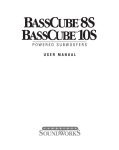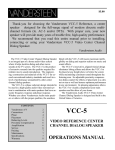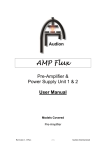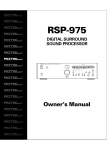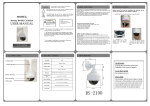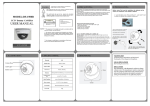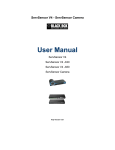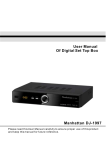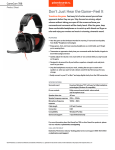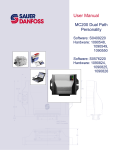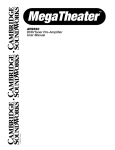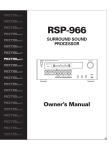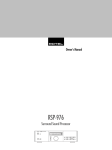Download P1000 and P500 Subwoofers
Transcript
™ P1000 and P500 Subwoofers User Manual ® The lightning flash with arrowhead, within an equilateral triangle, is intended to alert the user to the presence of uninsulated “dangerous voltage” within the product’s enclosure that may be of sufficient magnitude to constitute risk of electric shock to persons. The exclamation point within an equilateral triangle is intended to alert the user to the presence of important operating and maintenance (servicing) instructions in the literature accompanying this product WARNING AVISIQUE POUR EVITER TOUT RISQUE DE CHOC ELECTRIQUE, NE PAS DEMONTER LE COUVERCLE DU HAUT PARLEUR. AUCUN ENTRETIEN DES PIECES INTERIEURES N’EST REQUIS.TOUT SERVICE D’ENTRETIEN NE DOIT ETRE EFFECTUE QUE PAR DU PERSONNEL D’ENTRETIEN QUALIFIE. DO NOT OPEN TO PREVENT THE RISK OF ELECTRIC SHOCK, DO NOT REMOVE SUBWOOFER’S COVER. NO USERSERVICEABLE PARTS INSIDE. REFER SERVICING TO QUALIFIED SERVICE PERSONNEL. READ AND HEED IMPORTANT SAFETY WARNING ON BACK OF SUBWOOFER ENCLOSURE CAUTION: IMPORTANT NOTICE: TO PREVENT ELECTRIC SHOCK, MATCH WIDE BLADE OF PLUG TO WIDE SLOT, INSERT FULLY. THE SERIAL NUMBER FOR THE SUBWOOFER IS LOCATED ON THE SUBWOOFER’S CONTROL PANEL. PLEASE WRITE THIS NUMBER DOWN AND KEEP IT IN A SECURE AREA. THIS IS FOR YOUR SECURITY. ATTENTION: POUR EVITER LES CHOCS ELECTRIQUES, INTRODUIRE LA LAME LA PLUS LARGE DE LA FICHE DANS LA BORNE CORRESPONDANTE DE LA PRISE ET POUSSER JUSQU’AU FOND. 2 IMPORTANT SAFETY INSTRUCTIONS READ INSTRUCTIONS – All safety and operating instructions should be read before the subwoofer is operated. POWER-CORD PROTECTION – The AC power cords should be routed so that they are not likely to be walked on. No object should bring weight to bear on to the AC power cords. RETAIN INSTRUCTIONS – The safety and operating instructions should be retained for future reference. FOLLOW INSTRUCTIONS – All operating and use instructions should be followed. LIGHTNING – For added protection for the subwoofer or control module during a lightning storm, or when it is left unattended and unused for long periods of time, unplug them from the wall outlet. This will prevent damage to the subwoofer or control module due to lightning and power-line surges. CLEANING – Unplug the subwoofer or control module from the wall outlet or other power source before cleaning. Use a damp cloth for cleaning. OVERLOADING – Do not overload wall outlets, extension cords, or integral convenience receptacles as this can result in a risk of fire or electric shock. ATTACHMENTS – Do not use any adapters or attachments not recommended by Cambridge SoundWorks as they may cause hazards. OBJECT AND LIQUID ENTRY – Never use probes of any kind to reach into the subwoofer or control module as they may touch dangerous voltage points or short parts that could result in a fire or electric shock. Never spill liquid of any kind on the subwoofer, control module or control module power supply. HEED WARNINGS – All warnings on the subwoofer and in the operating instructions should be adhered to. WATER AND MOISTURE – Do not use the subwoofer or control module near water-for example, near a bath tub, wash bowl, kitchen sink, or laundry tub; in a wet basement; or near a swimming pool or other similar areas. SERVICING – Do not attempt to service the subwoofer or control module yourself as opening or removing covers may expose you to dangerous voltage or other hazards. Refer all servicing to qualified service personnel. ACCESSORIES – Do not place the subwoofer on an unstable cart, stand, tripod, bracket, or table. The subwoofer may fall, causing serious injury to a child or adult and serious damage to the product. DAMAGE REQUIRING SERVICE – Unplug the subwoofer or control module from the wall outlet or other power source and refer servicing to qualified service personnel under the following conditions: VENTILATION – Slots, openings and metal fins in the cabinet are provided for ventilation, to ensure reliable operation of the subwoofer and to prevent it from overheating. These areas must not be blocked or covered such as by placing the product on a bed, sofa, very deep pile rug, or other similar surface. The subwoofer should not be placed in a built-in installation such as a bookcase or rack. a) When the power-cord or plug is damaged. b) If liquid has been spilled, or objects have fallen into the subwoofer or control module. c) If the subwoofer or control module has been exposed to rain or water. HEAT – The subwoofer should be situated away from heat sources such as radiators, heat registers, stoves, and other products (including amplifiers) that produce heat. d) If the subwoofer or control module does not operate normally by following the operating instructions; or exhibits a distinct change in performance. POWER SOURCES – The subwoofer or control module should be operated only from the type of power source indicated on the label. If you are not sure of the type of power supply to your home, consult your dealer or local power company. e) If the subwoofer or control module has been dropped or damaged in any way. REPLACEMENT PARTS – When replacement parts are required, be sure the service technician uses replacement parts specified by Cambridge SoundWorks or have the same characteristics as the original part. Substandard substitutions may result in fire, electric shock, or other hazards. POLARIZATION – The subwoofer is equipped with a polarized alternating-current line plug (a plug having one blade wider than the other). This plug will fit into the power outlet only one way. This is a safety feature. If you are unable to insert the plug fully into the outlet, try reversing the plug. If the plug should still fail to fit, contact your electrician to replace your obsolete outlet. Do not defeat the safety purpose of the polarized plug. SAFETY CHECK - Upon completion of any service or repairs to the subwoofer or control module, ask the service technician to perform safety checks to determine that the subwoofer or control module is in proper operating condition. 3 CONTENTS 1 1. Powered subwoofer enclosure 2. Control module 3. AC power cable 4. Module to sub interface cable 5. Remote control 6. Speaker wire connector plug 7. Control module power supply adapter INSPECTING FOR DAMAGE Examine each part carefully for shipping damage. If there is any, do not install or use the system. Return the subwoofer to the store or merchant where you 2 made the purchase or call Cambridge SoundWorks at 1-800 FOR-HIFI (1-800-367-4434) for assistance. 0 40 -6 100 20 0 70 0 50 er equalizl leve er equaliz cy frequen volume phase s low-pas SPECIFICATIONS P1000: 7 Dimensions: 15 1/2"H x 15 1/4"W x 14"D Weight: 45 pounds P500: Dimensions: 13 1/2"H x 13 3/4"W x 12"D 3 4 Weight: 35 pounds VOLUME UP 5 VOLUME DOWN VOLUME UP VOLUME DOWN SUBWOOFER VOLUME SUBWOOFER VOLUME 6 4 OPERATING CONTROLS Adjust it for maximum output in this narrow range (not 1. low-pass: Even though a subwoofer only produces “bass for “best sound”). The affect this control has can be notes”, the upper end of its range should be tailored subtle. It’s easiest to adjust when percussion is playing to blend well with your main speakers. The sub- a repetitive pattern. woofer should not produce any bass your main 4. volume: speakers can produce. The low-pass control sets This control sets the overall output level of the sub- this limit. The lowest setting (50 Hz) should be used woofer. Adjust it with the remote control for the best with large main speakers. Its middle settings should overall blend with your main speakers, after you have be used with small floorstanding speakers or large set the other controls. bookshelf speakers. Its highest setting should be 5. equalizer level and equalizer frequency: used with small speakers (see table on page 14). Your listening room’s shape and construction (and 2. On/Standby/Limit Indicator: where you listen within it) have an unpredictable affect This indicator glows amber when the subwoofer is on deep bass. These two controls adjust deep bass. in Standby. The subwoofer uses very little power in equalizer frequency adjusts how deep into the bass this mode. It turns on rapidly whenever the main the subwoofer will respond. The 20 Hz setting indi- system is used. This indicator glows green while the cates the subwoofer is flat down to that frequency. subwoofer is On and operating. This indicator blinks equalizer level adjusts the output centered around the red whenever the subwoofer reaches its full output equalizer frequency setting. (1000 watts for the P1000, 500 watts for the P500). These controls let you discover the strong and deep 3. phase: sonic events in your favorite program material, part of The phase control compensates for placement dif- the fun of having a great powered subwoofer. ferences between the main speakers, the subwoofer and your listening position. Adjusting this control The lower you set the equalizer frequency and the higher affects the relatively narrow range of notes where you set the equalizer level, the more amplifier power you the main speakers and the subwoofer “overlap”. devote to producing the deepest bass. This, in turn, can limit the maximum overall output of your subwoofer. If you want maximum output, setting the equalizer frequency at or above 30 Hz can give it to you. 0 40 -6 100 20 0 70 0 50 r equalize cy frequen r equalize level volume phase low-pass 40 100 70 0 130 50 150 0 180 low-pass phase 1 3 2 0 11 volume 4 5 20 60 equalizer frequency 5 -6 +6 equalizer level 5 CONTROL MODULE INPUTS AND OUTPUTS 6. Sub In: 10. Main Outputs: Connect the SUB OUT jack from a receiver, integrat- Connect one of these two jacks to the subwoofer ed amplifier, preamplifier, or surround decoder to this enclosure using the supplied Interface Cable. Use the jack. Use an audio signal cable with single RCA other jack only when you to connect a second Newton plugs on each end. Series subwoofer enclosure. 7. Preamp Level Inputs: The Remote Control Normally, the Right (R) and Left (L) signal outputs The Remote Control adjusts the motorized volume con- from a preamp will connect to the to RIGHT IN and trol. Because the output level of deep bass in a room LEFT IN. The CENTER IN would only be used when can vary substantially from one place to another, it’s three equal-level signals need to be combined. best to adjust the subwoofer’s output from your listen- 8. Speaker Level Inputs: ing position. Connect the Right and Left speaker outputs of a stereo receiver/amplifier to the plug that inserts here. Connect the Right, Center and Left speaker outputs VOLUME UP of a Dolby Surround receiver in WIDE mode to the plug. 9. Right And Left High Pass Out: VOLUME DOWN Use these jacks if you have separate components (preamplifier and power amplifier) and you want to prevent the low frequency program material from reaching your main speakers. Connect these signal jacks to the Right (R) and Left (L) signal input jacks of SUBWOOFER VOLUME the power amplifier. Use a stereo audio signal cable with two RCA plugs on each end. Subwoofer Enclosure Input Panel POWER Powered Subwoofer 120VAC 7.0A INTERFACE JACKS 00000000 Connect the Interface Cable from the Control Module to one of these two jacks. 9 6 9 Control Module Input Panel CONTROL MODULE NO USER SERVICEABLE PARTS INSIDE REFER SERVICING TO QUALIFIED PERSONNEL SUB IN LEFT HIGH PASS OUT RIGHT HIGH PASS OUT Newton, Massachusetts USA Made in China + – + – + INTERFACE JACKS – 12V AC INPUT ON AUTO CENTER IN LEFT IN RIGHT IN PREAMP LEVEL INPUTS 7 OFF CENTER LEFT RIGHT SPEAKER LEVEL INPUTS 8 6 1 10 2 PLACEMENT The subwoofer enclosure should be placed on the floor. Its location in the room affects its output. The output increases the closer the subwoofer is placed to the intersection of walls and floors (see diagrams). Some Advantages Of Corner Placement: Placing a subwoofer in or near the corner of a room increases its maximum output. Corner placement also provides the most consistent output from deep bass to upper bass. Since corner placement “forces” more of the bass Maxium Bass Output energy toward the center of the room, you can operate the subwoofer at a lower overall gain setting than if it was in the middle of a wall. This reduces the amount of bass someone in a nearby room will hear. Other locations: Any position in a room can be used, but a position away from the intersection of two room surfaces will both reduce the maxiumn output of the subwoofer and make the output from deep bass to upper bass less even. For most places in a room, the orientation of the sub- Moderate Bass Output woofer is not critical. If you place the subwoofer directly in a corner, you may find that “diagonal” placement (the grille panels forming a 45 degree angle with both side walls) reduces wall-shaking. We realize many “real world” factors affect where you choose to place a subwoofer and corner placment may not be practical. The highly flexible controls on the Control Module allow you to effectively compensate for uneven output due to placement. Least Bass Output Ventilation: Because the subwoofer enclosure panel requires adequate ventilation, do not place it inside a wall unit or any piece of furniture. Also, don’t place it near heat sources or against furniture, draperies or other material that will block the free flow of air around the from underneath the subwoofer. 7 INSTALLING CARPET SPIKES Improving Stability With Carpet Spikes Back The powered subwoofer has four soft feet for level, stable orientation on any flat surface and tightly woven carpets. Installing and adjusting the four carpet spikes can level the speaker and improve its stability on thick carpeting. The spikes penetrate a carpet and carpet pad and transfer the weight of the speaker directly to the floor surface. Note: These carpet spikes will leave four small but distinct puncture holes in wooden floors and could damage other surfaces, especially if the subwoofer is Front dragged after they are installed. Do not use these spikes if you are concerned about the appearance of the floor beneath the carpet. Carpet spike installation consists of installing, adjusting, and locking the spikes. Determine the final position of the subwoofer before installing the carpet spikes, since repositioning a subwoofer is very difficult once the spikes are installed. 1) Screw one locknut about half-way down the shank of each carpet spike. 2) Prepare a soft surface on the floor in front of the subwoofer’s final position. Carefully upend the subwoofer so that its front panel (the one with the logo) rests on the soft surface. 3) Screw each carpet spike into one of the four threaded fittings. Leave a small gap between the locknut and the fitting. 4) Replace the subwoofer at its proper listening position. Adjust the spikes by lifting the subwoofer on the appropriate side and rotating the spikes until the speaker is level and stable. 5) Hand tighten each locknut (or use a wrench) against the base to secure the carpet spike, taking care not to rotate the spike. 8 CONNECTIONS RECEIVER After you have positioned the subwoofer enclosure, DIGITAL INPUTS to connect the Control Module to your audio SPEAKER OUTPUTS COAX MAIN RIGHT OPTICAL components. MAIN LEFT CENTER SUB OUT About your audio components: You can connect the REAR RIGHT Control Module to a receiver, an integrated amplifier, a SIGNAL CABLE WITH RCA PLUGS REAR RIGHT preamplifier/power amplifier combination or other This jack is usually labeled "SUB OUT," but it may say "SUBWOOFER" or "LFE OUTPUT". Check the receiver owner's manual to identify it. audio component with line level or speaker level outputs. For brevity, this guide will usually refer only to a CONTROL MODULE NO USER SERVICEABLE PARTS INSIDE REFER SERVICING TO QUALIFIED PERSONNEL SUB IN “receiver,” but the instructions will also apply to any LEFT HIGH PASS OUT RIGHT HIGH PASS OUT Newton, Massachusetts USA Made in China + – + – + INTERFACE JACKS – 12V AC INPUT ON audio component. AUTO OFF CENTER IN LEFT IN RIGHT IN PREAMP LEVEL INPUTS You can connect the Control Module to a receiver’s line CENTER LEFT RIGHT SPEAKER LEVEL INPUTS 1 2 Dolby Digital and Dolby Surround receiver Line level connector level output (one or two RCA jacks) or its speaker level outputs, but not both. Always disconnect the AC power to the Control Module and the subwoofer enclosure before making or changing any connections. Line Level Connections For most line level connections, you need a signal INPUTS R POWER AMPLIFIER L cable with an RCA plug at both ends. Connect the IN Control Module in the following ways: Dolby Digital receiver: Connect a mono signal cable from the RCA jack output labeled SUB OUT (or possibly labeled LFE or just SUB) on the receiver to the SUB IN input on the Control Module. CONTROL MODULE NO USER SERVICEABLE PARTS INSIDE REFER SERVICING TO QUALIFIED PERSONNEL SUB IN LEFT HIGH PASS OUT RIGHT HIGH PASS OUT Dolby Surround receiver (with or without Pro Logic): Connect a signal cable from the SUB OUT RCA jack (also labeled LINE OUT, AUDIO OUT, or just SUB) to the SUB IN input on the Control Module. Newton, Massachusetts USA Made in China + – + – + 00000000 INTERFACE JACKS – 12V AC INPUT ON AUTO OFF CENTER IN LEFT IN RIGHT IN PREAMP LEVEL INPUTS Preamplifier/power amplifier: Connect a stereo signal cable with RCA plugs at each end from the LEFT and RIGHT preamp outputs to the RIGHT IN and LEFT IN inputs on the Control Module. Connect another stereo signal cable from the RIGHT HIGHPASS OUT and LEFT HIGH-PASS OUT outputs of the Control Module to the LEFT and RIGHT inputs on your stereo power amplifier (or the FRONT LEFT and FRONT RIGHT inputs of a multi-channel power amplifier.) CENTER LEFT RIGHT SPEAKER LEVEL INPUTS 1 2 INPUTS R L CD IN IN IN OUTPUTS R AUX TAPE OUT TAPE L IN PREAMP IN OUT Preamplifier/Power amplifier level connectors Once your line-level connection is made between the receiver and Control Module, skip to “Connect the Subwoofer Enclosure,” page 11. 9 Speaker Level Connection TO FRONT LEFT & RIGHT SPEAKERS If your receiver does not have a line-level audio signal output or if you wish to bypass this output, you need to connect the speaker level inputs of the Control Module DIGITAL INPUTS to your receiver’s speaker outputs. SPEAKER OUTPUTS COAX MAIN RIGHT OPTICAL We provide a Speaker Wire Connector with two short Red Band MAIN LEFT lengths of speaker wire already connected to it. (If White Band CENTER wires are not long enough to reach from the Control SUBWOOFER Module to your power amplifier, you need to attach REAR RIGHT OUT longer speaker wires. How to do this is described in REAR RIGHT “Attaching longer speaker wires” at the bottom of this page.) Connect plug to speaker output TO SUB'S SPEAKER LEVEL INPUTS The speaker wire marked with a red band is Right postive. The unmarked wire next to it is Right negative. The Left Positive speaker wire is marked with a white 5/8" band. The unmarked speaker wire next to it is Left negative. Ridge on One Side receiver end Connect the speaker wires to your receiver’s Left and Cambridge SoundWorks Camb rid ge So und Works Cambride Printing on One Side Right speaker outputs (Front Left and Front Right speaker outputs of a multi-channel receiver). You will have to “parallel connect” theses wires with the main Different Color Conductors connector end speaker wires (see diagram). Positive speaker output 3/8" terminals will usually be colored red and have a “+” Prepare Wire Identify Wire Marking symbol. Negative speaker output terminals will usually be colored black and have a “–” symbol. Finally, insert the Speaker Wire Connector plug into the LEFT Connect plug to Control Module Note Positive (+) Negative (–) Sequence Attaching longer speaker wires: First, prepare two suitable lengths of speaker wire. You can use lightweight (18-22 gauge) speaker wire because this wire will not carry any significant electric current. Also, wire RIGHT (CENTER) larger than 18 gauge will be somewhat harder to connect in tandem with another speaker wire. Strip off 5/8” of insulation from one end of each MODULE CONTROL INSIDE E PARTS SERVICEABL FIED PERSONNEL NO USER QUALI CING TO REFER SERVI speaker wire. Strip of 3/8” of insulation from the other SUB IN end. This end connects to the Speaker Wire RIGHT USA achusetts Newton, Massin China Made LEFT HIGH PASS OUT – + HIGH PASS OUT + – + CENTER S RIGHT LEVEL INPUT SPEAKER Wire Connector to Module 10 ON AUTO OFF 1 LEFT IN IN CENTER S RIGHT IN LEVEL INPUT PREAMP Connector Plug. 12V AC INPUT JACKS INTERFACE – LEFT 2 jack in the Control Module. Tighten each set screw to hold the wires in place. To insure you connect the wires properly (positive to Connect to the Subwoofer Enclosure: Once the positive, negative to negative), note which of each input connections are made to the Control Module, speaker wire’s two conductors is “marked”. This mark- connect the Interface Cable from the Control Module ing may be a ridge in the insulation, different colored to the Subwoofer Enclosure. conductors or printing on only one side. Use the The interface Cable has plugs that look and connect marked side of the speaker wire to connect the posi- like telephone connector plugs. The plugs are the tive speaker terminals. Use the other wire for the nega- same at both ends. tive terminals. Making sure both the Control Module and Using a small flat bladed screwdriver, loosen the four subwoofer enclosure are disconnected set screws inside the Speaker Wire Connector plug. from any AC power source. Pull out the short speaker wires. Note: The second Interface Cable jack on the subFollowing the markings on the Speaker Wire Connector woofer enclosure allows you to connect a Newton diagram (for Right positive, Right negative and so on), Series second subwoofer enclosure with a sub to sub insert the correct wires into the plug’s openings. MODULE CONTROL INSIDE E PARTS SERVICEABL FIED PERSONNEL NO USER QUALI CING TO REFER SERVI SUB IN USA achusetts Newton, Massin China Made LEFT HIGH PASS OUT RIGHT + HIGH PASS OUT LEFT IN CENTER S RIGHT IN LEVEL INPUT PREAMP IN – + – + CENTER S RIGHT LEVEL INPUT SPEAKER 12V AC INPUT JACKS INTERFACE – ON Powered Subwoofer AUTO POWER OFF LEFT 1 120VAC 7.0A 2 00000000 INTERFA CE JACKS 11 FINAL SETUP interface cable. Power Connections First, insert the AC plug of the Control Module’s power Powered Subwoofer supply adapter into an AC outlet. Then insert the POWER 120VAC 7.0A 00000000 INTERFAC E JACKS adapter’s output plug into the Control Module’s 12V AC input jack. Turn the Control Module’s power switch to AUTO. Insert the subwoofer enclosure’s power cable into the receptacle on the subwoofer enclosure’s input panel. Then insert the AC plug into an AC outlet. Turn the subwoofer enclosure’s power switch ON. SUB IN RIGHT HIGH PASS OUT Remote Control LEFT HIGH PASS OUT NO USER + CONTROL MODULE SERVICEABLE Newton, Massac REFER SERVICIN PARTS INSIDE husetts G TO QUALIFIE Made in China USA D PERSON NEL – + – + – INTERFACE JACKS RIGHT IN CENTER IN LEFT IN PREAMP LEVEL INPUTS The remote control adjusts the VOLUME setting, an AUTO 1 adjustment best made from your listening position. The battery inside the remote should last for a year or two. When you need to replace it, use a small pointed object (paper clip, pen, toothpick) to release the battery holder (see diagram). The battery type is CR2032 (3V) and is available wherever wrist watch and hearing aid batteries are sold. Test Your Connections VOLUME UP Once all connections have been made, test your sound system to verify the subwoofer produces bass VOLUME DOWN output. Advance the Bass Level control to the 10 o’clock position. Turn on your receiver and play a CD or movie you know to have significant bass. Listen for subwoofer output as you increase your receiver’s SUBWOOFER VOLUME volume control up to a moderate volume level. If you don’t hear any output from the subwoofer, slowly advance the subwoofer’s Bass Level (preferably via the remote control). If you don’t get any output, 12 12V AC INPUT ON RIGHT CENTER SPEAKER LEVEL INPUTS LEFT 2 OFF 0 40 recheck your connections. Adjusting For Best Performance We recommend you adjust the Control Module according to the following sequence: 20 1. Set the equalizer controls. -6 60 +6 equalizer level equalizer frequency 2. Set the low pass control. 3. Set the volume control by ear. 1. Set The Controls 4. Set the phase control by ear. 5. Reset the volume control (if necessary). 6. Adjust the equalizer frequency and equalizer level controls to your preference. 0 Adjustment: 40 -6 100 1. Start with the equalizer level set to 0 (straight up) 20 0 70 0 and the equalizer frequency control set to approxi- 50 volume phase low-pass mately 30 Hz (see diagram at the top of the page). 2. Adjust the low pass control according to the Low Pass Control Settings Table on the opposite page. VOLUME UP 3. Set the subwoofer’s volume with the supplied remote control. Use some of your favorite program VOLUME DOWN material (video or audio). Adjust the output level until you are happy with the overall bass balance. 4. Adjust the phase control. This control’s action will SUBWOOFER VOLUME be subtle. Make this adjustment from your listening 3. Adjust Volume position. If the control module is not within easy reach, have someone else adjust this control while you listen. phase control adjustment: Play some program material with constant, regular bass (like a kick drum beat). Rotate the phase control back and forth across its full range and listen for an increase in output. The output difference you hear could be anything from negligible to significant. However large 0 the difference, leave this control set where it has the 180 phase maximum effect. 4. Adjust Phase If you do not hear any difference in the bass output, skip Step 5. 13 er equaliz cy frequen er equalizl leve 2. LOW-PASS CONTROL SETTINGS The low-pass control on the front panel of the Control Module is continuously variable from 50 Hz to 150 Hz. The following recommendations describe setting the control at the five indicated positions on the dial (50, 70, 100, 130, and 150 Hz), but intermediate settings are also functional. Dolby Digital sound systems 100 A Dolby Digital decoder provides its own “bass management” processing when you activate the decoder’s “SUB OUT” jack. Set the Newton Series powered subwoofer’s low-pass control to 150 Hz in this case. ® 100 70 130 50 150 low-pass 70 130 50 100 70 130 50 150 130 Hz 100 70 130 50 low-pass 100 Hz 100 130 50 150 70 Hz The following recommendations apply when both your main left and right speakers and your subwoofer are driven by a full range signal. This is the case in a stereo component system or a Dolby Surround with Pro Logic system. 100 70 130 50 150 low-pass 50 Hz 14 Use this setting for large size bookshelf speakers and small floor standing speakers. Use this setting with these Cambridge SoundWorks main speakers: Model 6 Tower III Newton Series M60 Newton Series M80 Newton Series MC500 low-pass Dolby Surround (Pro Logic) and Stereo sound systems Use this setting for medium size bookshelf speakers. Use this setting with these Cambridge SoundWorks main speakers: Model 17 Ambiance 62 Ambiance 82 Newton Series M50 Newton Series MC300 150 70 Use this setting for larger satellite main speakers and the smallest bookshelf speakers. Use this setting with these Cambridge SoundWorks main speakers: Ambiance 52 MovieWorks satellites Ensemble satellites Ensemble II satellites Newton Series MC200 low-pass Stereo sound systems using the Control Module’s high-pass outputs. The Control Module’s high-pass outputs block all low frequencies below 100 Hz. Set the low-pass control 100 on the front panel no lower than 100 Hz when using 70 130 these outputs. If your main speakers are medium-sized 50 150 bookshelf speakers or low-pass smaller, set the low-pass control to 130 Hz or 150 Hz, 100 Hz as described in the Dolby Surround (Pro Logic) and Stereo sound section that follows. Ensemble III satellites Ensemble IV satellites 150 Hz 150 Hz Note: Be sure to set the LARGE SPEAKER/ SMALL SPEAKER option for the Front, Center and Rear channels of the Dolby Digital decoder. Unless your main speakers are quite large (floorstanding types with a ten inch woofer or larger), we recommend choosing the SMALL SPEAKER option. This insures a smooth transistion between your main speakers and the Newton Series subwoofer, and that the subwoofer handles all the deep bass output. 150 low-pass Use this setting for small “satellite”type main speakers (“minispeakers”) or any speaker with a single four-inch low frequency driver or smaller. Use this setting with these Cambridge SoundWorks main speakers: Use this setting for large floor-standing speakers. Use the setting with these Cambridge SoundWorks main speakers: Tower II Tower Newton Series T300 Newton Series T500 0 40 5. If you find the increase in output contributed by the phase control is more than you care for, reduce the 6. Set the Controls volume control setting to bring the subwoofer output -6 back in balance. +6 equalizer level 20 60 equalizer frequency Congratulations! You have now adjusted the subwoofer to blend well with your main speakers. d) You may wish to repeat this adjustment procedure with some different musical or video program pas- 6. The equalizer frequency and equalizer level sages. Remember, there is no “perfect” setting for controls: these controls. Once you have found a setting is Your listening room’s shape and construction have an good for a few recordings, you can reliably consider unpredictable but significant effect on how strong the the adjustment complete. deep bass output is at your listening position. These controls adjust the strength of the deep bass without Normal Use: affecting the subwoofer’s blend with the main speak- Afterwards, if you find you want more or less bass out- ers. Follow this last procedure to adjust them. put from your system, either adjust any available tone a) Adjust the equalizer level setting up to about controls on your receiver or adjust the volume control 3 o’clock (see diagram in next column). From your on the Control Module. listening position, play the passage you used previ- We hope you enjoy the new sonic dimensions your ously to adjust the subwoofer volume. It should be Newton Series powered subwoofer reveals to you! easy to hear the effect of the control on deep bass content. Repeat the passage at different equalizer Fuse Replacement level settings. Make sure you assess the settings The fuse holder is located on the base of the sub- from your normal listening position. Leave the con- woofer. Both subwoofer models use a metric 5X20mm trol at your preferred setting. size fuse, 7A. b) Play the same passage again and listen to higher To replace the fuse: 1) Unplug the AC cord from the AC power source, then remove the AC power cord from the speaker. 2) Remove the fuse cap with a small, flat blade screwdriver (see first and second diagram). 3) Replace the fuse inside the fuse cap with another metric 5X20mm size fuse, 7 A (see third diagram). 4) Replace the fuse and cap in the subwoofer. 5) Restore the sub to an upright position. 6) Connect the AC power cord first to the subwoofer and then to the power source. and lower settings of the equalizer frequency control from your preferred listening posititon. For recordings with deep bass content, setting the equalizer frequency control below 30 Hz will produce highly accurate and room-shaking results as it reveals near-infrasonic signals. There are only two main reasons to set this control above 20 Hz – the very deep bass bothers people in adjoining rooms or the overall output level isn't as strong as you would like. If you have a large room, or desire very high sound pressure levels, setting the equalizer frequency control at 30 Hz or higher will still 7A 250V overall output. FU FU SE RISK OF FIRE REPLACE FUSE AS MARKED SE provide good deep bass, but will allow greater T Fuse Replacement 15 P81-1630 Rev A
















